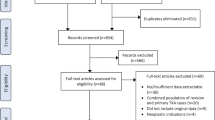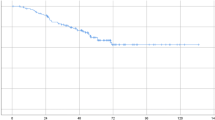Abstract
Purpose
The use of ‘hinged’ knee prostheses for primary knee arthroplasty procedures is increasing. This analysis reports the rates of implant survival, modes of failure, revision details and functional outcomes with particular reference to the primary indication for surgery for a cohort of patients treated with primary hinged knee replacement.
Methods
Systematic review with supplementary analysis using data from the National Joint Registry and Department of Health. Analysis included 964 patients undergoing primary hinged knee replacement between April 2003 and December 2010. Survival at a maximum of 7 years was calculated for the group as a whole and dependent upon the indication for surgery (osteoarthritis vs. rheumatoid/inflammatory arthritis vs. post-traumatic arthritis). Functional outcomes (pre- and post-operative Oxford Knee and Euroqol-5D scores and post-operative satisfaction) were available for 46 patients.
Results
In total, 20 cases required revision. The 5-year survival rate (96.8 % [95 % CI 95.1–98.4 %]) was not dependent upon the primary surgical indication (p = n.s.). The commonest reasons for revision were infection (8 cases), peri-prosthetic fracture (4 cases) and aseptic loosening (3 cases). Patients reported substantial improvements in their Oxford Knee Score (mean improvement = 17.6, [95 % CI 14.4–20.8]) and EQ5D index (mean improvement = 0.357, [95 % CI 0.248–0.467]). Levels of post-operative satisfaction were high.
Conclusions
Hinged knee replacement can be considered as a viable alternative to more traditional unconstrained designs in the complex primary setting. These findings are clinically relevant as they support the increasing use of hinged knee replacements for the arthritic knee in which there is concomitant severe bone loss, deformity or instability. Surgeons using these implants can have confidence that their mid-term performance is comparable to more conventional knee designs.
Level of evidence
Prospective cohort study, Level II.


Similar content being viewed by others
References
(2009) Annual report 2009: hip and knee Arthroplasty September 1998 to December 2008. Australian Orthopaedic Association National joint Replacement Registers. http://www.dmac.adelaide.edu.au/aoanjrr/documents/aoanjrrreport_2009.pdf. Last accessed 28 Aug 2012
(2010) 8th annual report 2010. National Joint Registry for England and Wales. http://www.njrcentre.org.uk/njrcentre/ReportsPublicationsandMinutes/Annualreports/tabid/86/Default.aspx. Last accessed 28 Aug 2012
(2010) Danish Knee Arthoplasty Register: annual report 2010. www.knee.dk/groups/dkr/pdf/DKRreportEnglish2010.pdf. Last accessed 8 Oct 2012
Appleton P, Morgan M, Houshian S, Robinson CM (2006) Distal femoral fractures treated by hinged total knee replacement in elderly patients. J Bone Joint Surg (Br) 88(8):1065–1070
Armitage P, Berry G (1994) Statistical methods in medical research, 3rd edn. Blackwell, Oxford
20 ASA physical status classification system. http://www.asahq.org/clinical/physicalstatus.htm. Last accessed 28 Aug 2012
Baker P, Cowling P, Kutz S, Jameson S, Gregg P, Deehan D (2012) Reason for revision influences early patient outcomes after aseptic knee revision. Clin Orthop Relat Res 470(8):2244–2252
Baker PN, van der Meulen JH, Lewsey J, Gregg PJ (2007) The role of pain and function in determining patient satisfaction after total knee replacement: data from the National Joint Registry for England and Wales. J Bone Joint Surg (Br) 89-B:893–900
Böhm P, Holy T (1998) Is there a future for hinged prostheses in primary total knee arthroplasty? A 20-year survivorship analysis of the Blauth prosthesis. J Bone Joint Surg (Br) 80(2):302–309
Cameron HU, Jung YB (1990) Hinged total knee replacement: indications and results. Can J Surg 33(1):53–57
Choong PF, Sim FH, Pritchard DJ, Rock MG, Chao EY (1996) Megaprostheses after resection of distal femoral tumors. A rotating hinge design in 30 patients followed for 2–7 years. Acta Orthop Scand 67(4):345–351
Dawson J, Fitzpatrick R, Murray D, Carr A (1998) Questionnaire on the perceptions of patients about total knee replacement. J Bone Joint Surg (Br) 80:63–69
Euroqol (EQ5D) score. Accessed at http://www.euroqol.org/home.html. Last accessed 11 July 2011
Guenoun B, Latargez L, Freslon M, Defossez G, Salas N, Gayet LE (2009) Complications following rotating hinge Endo-Modell (Link) knee arthroplasty. Orthop Traumatol Surg Res 95(7):529–536
Hannan MT, Felson DT, Dawson-Hughes B, Tucker KL, Cupples LA, Felson DT, Kiel DP (2000) Risk factors for longitudinal bone loss in elderly mean and women: the Framingham Osteoporosis Study. J Bone Miner Res 15(7):710–720
Hernandez-Vaquero D, Sandoval-García MA (2010) Hinged total knee arthroplasty in the presence of ligamentous deficiency. Clin Orthop Relat Res 468:1248–1253
Hwang SC, Kong JY, Nam DC, Kim DH, Park HB, Jeong ST, Cho SH (2010) Revision total knee arthroplasty with a cemented posterior stabilized, condylar constrained or fully constrained prosthesis: a minimum 2-year follow-up analysis. Clin Orthop Surg 2(2):112–120
KAT Trial Group, Johnston L, MacLennan G, McCormack K, Ramsay C, Walker A (2009) The Knee Arthroplasty Trial (KAT) design features, baseline characteristics, and two-year functional outcomes after alternative approaches to knee replacement. J Bone Joint Surg (Am) 91(1):134–141
Kawai A, Healey JH, Boland PJ, Athanasian EA, Jeon DG (1999) A rotating-hinge knee replacement for malignant tumors of the femur and tibia. J Arthroplast 14(2):187–196
Lachiewicz PF, Soileau ES (2006) Ten-year survival and clinical results of constrained components in primary total knee arthroplasty. J Arthroplast 21(6):803–808
Lidgren L, Robertsson O, W-Dahl A (2009) Annual report 2009. The Swedish Knee Arthroplasty Register. http://www.knee.nko.se/english/online/uploadedFiles/113_SVK2009ENGL1.0.pdf. Last accessed 28 Aug 2012
Mavrodontidis AN, Andrikoula SI, Kontogeorgakos VA, Babis GC, Xenakis TA, Beris AE, Soucacos PN (2008) Application of the Endomodel rotating hinge knee prosthesis for knee osteoarthritis. J Surg Orthop Adv 17(3):179–184
Morgan H, Battista V, Leopold SS (2005) Constraint in primary total knee arthroplasty. J Am Acad Orthop Surg 13(8):515–524
Petrou G, Petrou H, Tilkeridis C, Stavrakis T, Kapetsis T, Kremmidas N, Gavras M (2004) Medium-term results with a primary cemented rotating-hinge total knee replacement. A 7- to 15-year follow-up. J Bone Joint Surg (Br) 86(6):813–817
Robertsson O, Dunbar M, Pehrsson T, Knutson K, Lidgren L (2000) Patients satisfaction after knee arthroplasty: a report on 27,372 knees operated on between 1981 and 1995 in Sweden. Acta Orthop Scand 71(3):262–267
Snelling A, Crespo C, Schaeffer M, Smith S, Walbourn L (2001) Modifiable and non-modifiable factors associated with osteoporosis in postmenopausal women: results from the third National Health and Nutrition Examination Survery, 1988–1994. J Womens Health Gend Based Med 10(1):57–65
Sprenger TR, Doerzbacher JF (2002) Long-term follow-up of the GSB II total knee used in primary total knee arthroplasty. J Arthroplast 17(2):176–183
van Loon CJ, Pluk C, de Waal Malefijt MC, de Kock M, Veth RP (2001) The GSB total knee arthroplasty. A medium- and long-term follow-up and survival analysis. Arch Orthop Trauma Surg 121(1–2):26–30
Yang JH, Yoon JR, Oh CH, Kim TS (2012) Primary total knee arthoplasty using rotating-hinge prosthesis in severely affected knees. Knee Surg Sports Traumatol Arthrosc 20:517–523
Acknowledgments
We thank the patients and staff of all the hospitals in England and Wales who have contributed data to the National Joint Registry. We are grateful to the Healthcare Quality Improvement Partnership (HQIP), the NJR steering committee and the staff at the NJR centre for facilitating this work. This work was funded by a fellowship from the National Joint Registry. The authors have conformed to the NJR’s standard protocol for data access and publication. The views expressed represent those of the authors and do not necessarily reflect those of the National Joint Register Steering committee or the Health Quality Improvement Partnership (HQIP) who do not vouch for how the information is presented.
Author information
Authors and Affiliations
Corresponding author
Rights and permissions
About this article
Cite this article
Baker, P., Critchley, R., Gray, A. et al. Mid-term survival following primary hinged total knee replacement is good irrespective of the indication for surgery. Knee Surg Sports Traumatol Arthrosc 22, 599–608 (2014). https://doi.org/10.1007/s00167-012-2305-y
Received:
Accepted:
Published:
Issue Date:
DOI: https://doi.org/10.1007/s00167-012-2305-y




